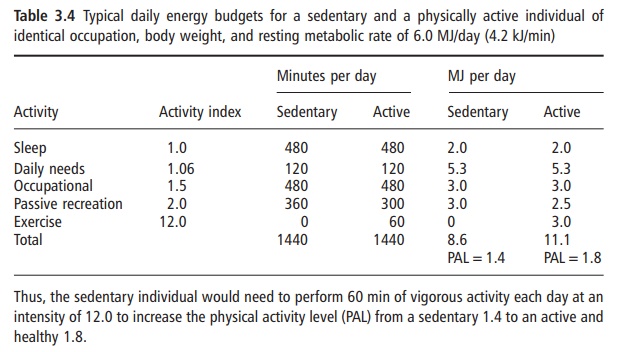Chapter: Introduction to Human Nutrition: Energy Metabolism
Energy requirements - Human Nutrition: Energy Metabolism
Energy requirements
How much energy do we need to sustain life and maintain our body
energy stores? Why do some people require more energy and others less? In other
words, what are the energy requirements of different types of people? Based on
our earlier definition of energy balance, the energy needs or energy
require-ments of the body to maintain energy balance must be equal to total
daily energy expenditure. Total daily energy expenditure is the sum of the
individual com-ponents of energy expenditure as discussed previ-ously, and
represents the total energy requirements of an individual that are required to
maintain energy balance. Until recently, there was no accurate way to measure
total energy expenditure or energy needs of humans. The DLW technique has
provided a truly noninvasive means to measure accurately total daily energy
expenditure, and thus energy needs, in free-living humans. Before DLW, energy
requirements were usually assessed by measurement or prediction of RMR, the
largest component of energy require-ments. However, since the relationship
between RMR and total energy expenditure is highly variable because of
differences in physical activity, the estimation of energy needs from knowledge
of RMR is not that accurate and requires a crude estimate of physical activity
level. Nevertheless, reasonable estimates can be made to estimate daily energy
budgets for indi-viduals (Table 3.4).

Following the validation of DLW in humans, this technique has
been applied to many different popula-tions. Total energy expenditure is often
compared across groups or individuals using the ratio of one’s total energy
expenditure to RMR, or physical activity level (PAL). Thus, for example, if the
total energy expenditure was 12.6 MJ/day and the RMR was 6.3 MJ/day, the PAL factor
would be 2.0. This value indicates that total energy expenditure is twice the
A low PAL indicates a sedentary lifestyle, whereas a high PAL represents a highly active lifestyle. The highest recorded sustained PAL in humans was recorded in cyclists participating in the Tour de France road race. These elite athletes could sustain a daily energy expenditure that was up to five times their RMR over extended periods. Smaller animals, such as migrating birds, have a much higher ceiling for achieving higher rates of total energy expen-diture, which can reach up to 20 times their RMR.
Factors such as body weight, FFM, and RMR account for 40–60% of
the variation in total energy expenditure. Total energy expenditure is similar
between lean and obese individuals after taking into account differences in
FFM. Thus, fatness has small, but important, additional effects on total energy
expenditure, partly through RMR, as discussed previ-ously, but also by
increasing the energetic cost of any physical activity.
WWith regard to age, some studies suggest that only a limited
change in total energy expenditure (relative to RMR) occurs from childhood to
adulthood, but that a decline occurs in the elderly. Recent data also suggest a
gender-related difference in total energy expenditure, in addition to that
previously described for RMR. In a meta-analysis that examined data from a
variety of published studies, absolute total energy expenditure was significantly
higher in males than in females by 3.1 MJ/day (10.2 ± 2.1 MJ/day in females,
13.3 ± 3.1 MJ/day in males), and nonresting energy expenditure remained higher
in men by 1.1 MJ/day.
Individuals who have sedentary occupations and do not
participate frequently in leisure pursuits that require physical activity
probably have a PAL factor in the region of 1.4. Those who have occupations
requiring light activity and participate in light physi-cal activities in
leisure time probably have a PAL around 1.6 (this is a typical value for
sedentary people living in an urban environment). Individuals who have
physically active occupations and lifestyles prob-ably have a PAL greater than
1.75. It has been sug-gested that the optimal PAL that protects against the
development of obesity is around 1.8 or higher. Increasing one’s physical
activity index from 1.6 to 1.8 requires 30 min of daily vigorous activity, or
60 min of light activity (Table 3.4).
Related Topics